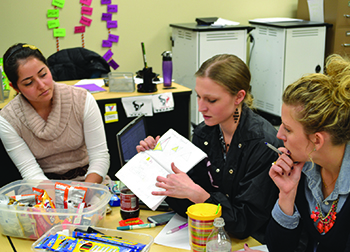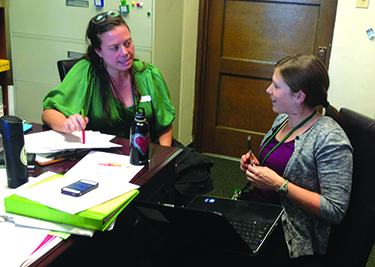Not far from the heart of Houston, unlikely alliance between a school district and nearby charter schools is bringing the best of both worlds to area students. As with most breakthroughs, the catalyst was simple curiosity. Duncan Klussmann, superintendent of schools for the Spring Branch school district, wondered just what was going on in those high-performing charter schools peppered around Houston, where both YES Prep and KIPP (Knowledge Is Power Program) operated several schools. Did they know something he needed to know?

Photo courtesy Denver Public Schools
Klussmann is a folksy, salt-of-the-earth kind of guy and a very traditional superintendent. But he did something most superintendents would never do: he scheduled a visit to a YES Prep school and spent some time with founder Chris Barbic. “I was really impressed with the culture, the environment, the interaction with the kids,” Klussmann recalled. “As I tell people, I often gauge things by whether my own three kids are missing out on something by not being part of a really good program.”
About a year later, Klussmann accepted an invitation to visit a KIPP school. Again, he liked what he saw. What stuck in his mind was the special classroom culture. Most of all, he liked the urgency: these teachers taught like their “hair was on fire,” to borrow a line from famed Los Angeles teacher Rafe Esquith.
How, Klussmann wondered, could I import some of that special sauce into my schools? And then he found a way. Why not make charter operators partners rather than competitors? We have what they want, great buildings and access to thousands of students they otherwise would have little chance of reaching. And they have that special culture we need to adopt.
So he did something else that most school superintendents would never even consider: he invited both YES Prep and KIPP to take up residency in two middle schools, building grade-by-grade expansions that would lead to YES Prep establishing a high school program within an existing Spring Branch high school.
Turns out Klussmann was on to something. More than 20 public school districts across the country, including the large urban districts of Boston, Chicago, Los Angeles, and Philadelphia, have quietly entered into “compacts” with charters and thereby declared their intent to collaborate with their charter neighbors on such efforts as professional development for teachers and measuring student success.
Striking a Bargain
The political appeal of district-charter compacts is evident. For mayors who have long admired the top charter schools in their cities but also remain wary of crossing the politically potent teachers unions that are hostile to charters, the “compact” designation nicely reduces the political heat. No longer is it districts (and their unions) against charters; it’s districts embracing charters. Who could be against that?
Unfortunately, it’s too soon to celebrate the end of the charter school wars. Compacts are still few in number, and not all have moved their districts past long-standing grievances (see, for example, “Boston and the Charter School Cap,” features, Winter 2014).
“Today we are on the battlefield of an ugly, nonproductive war on charters, all while children are stuck in underperforming public schools,” said Joseph DiSalvo, a former San Jose teacher and current member of the Santa Clara County Board of Education, which serves as an appeal board for charters rejected by school districts in the San Jose area.
District-charter compacts are sometimes a mere footnote to what remain caustic charter school battles, such as the one that took place in early 2014 in New York City. Newly elected New York City mayor Bill de Blasio moved to rein in the Success Academy charters run by his former political rival, Eva Moskowitz, by cancelling agreements that enabled charter schools to operate within district school buildings. Like anticharter forces elsewhere in the country, de Blasio chose the city’s highest-performing charter to attack. The higher the performance, the bigger the threat.
On the opposite side of the spectrum are compacts in Denver, the Texas district of Aldine, and Spring Branch, where superintendents are embracing high-performing charters by inviting them into their schools. These efforts couldn’t be more different from the contentious co-locations in New York City that sparked de Blasio’s ire. In cities with well-developed compacts, the charter and district principals and teachers constantly rub elbows to learn from one another. Even within contentious Santa Clara County, where most of the San Jose–area superintendents are doing their best to stiff-arm charter schools, the Franklin-McKinley school district brings in charters as welcome partners.
Why would these school superintendents lower the drawbridge while others are digging deeper moats to keep charters out? The compacts fill needs on both sides. School districts want to import some of the classroom culture and sense of urgency they see in charter schools. Some want charters to take more special education students or to hold low-performing charter-school operators to account. Fair enough. Best of all, they get to “claim” the test scores turned in by the charter students. What mayor or school superintendent doesn’t want to see headlines about rising test scores? Charter school leaders need building space and can pursue the mission of many charters, to help improve the broader system.
Compacts thus help top charter groups deal with two political Achilles heels that now limit their growth: special education and better accountability for low-performing charters. By coordinating special education with the district and setting common performance metrics for low-performing charters, compacts make the charter operators more politically palatable.
Finally, district compacts offer access to thousands of students charters might not otherwise reach. Says Mark DiBella, the Houston superintendent for YES Prep,
Our district partnerships have allowed us to expand beyond our growth model. Since charter schools do not receive any facility funding from the state of Texas, without our district partnerships our growth model showed that we could only fund raise enough to open 11 campuses. However, because of our co-located partnerships, which save us the upfront capital investment when starting a school, today we have 13 campuses—two of which are district partnerships. Furthermore, without district partnerships our growth model for the next five years would only allow us to open five additional schools. With our partnerships, we will be able to open a sixth school as well. This means that by the end of our next phase of growth, partnerships will have added more than 3,000 students to our overall enrollment capacity.
Should they prove effective over time, these compacts could help overcome the limits on growth that have long stymied high-performing charters (roughly defined as the top fifth of all charters): If you can’t find building space, and you can only expand by a grade a year, how can you ever reach a critical mass of students? Suddenly there’s an answer: view the district as a potential partner rather than a competitor, and you’ll be invited to the big dance.
The Gates Foundation now funds district-charter collaboration through formal “compacts” in 20 different cities. Gates support, which usually begins with planning grants of $100,000, pays for joint professional development; for designing a universal enrollment system; for establishing common metrics for evaluating all students, regardless of school type; and for creating more personalized learning for students.
Especially intriguing about the Gates-funded compacts is their top quarterback, Don Shalvey, a former district superintendent who also founded Aspire Public Schools. Shalvey, who is someone with credibility on both sides of the district-charter divide, now runs the Gates program. Think of Shalvey as a Bill Clinton figure. He may no longer be president, but when he comes to town to promote a favored cause, doors open. Suddenly, superintendents dare to think differently.
It’s tempting to dismiss compacts as lightweight fads, particularly if one focuses on districts where district-charter tensions are still paramount. Top charter schools also insist that there’s no way to dilute the brand and still achieve success. Charters that succeed with low-income children go full bore: all-out culture building in the classroom, students and staffers willing to endure longer school hours, bright teachers willing to adapt to precise training regimens and relinquish a fair amount of privacy (giving out their cell-phone number for afterschool homework questions, for example). How could that culture possibly mesh with schools that recruit from traditional education colleges and run according to union contracts?
The four district-charter compacts—Denver, Colorado; Aldine, Texas; the Houston-area Spring Branch district; and Franklin-McKinley in San Jose, California—reveal the variety of forms compacts can take as they seek to answer that question. First up is Spring Branch, a compact that has a promising template for others to imitate.
Spring Branch
Independent School District, Houston, Texas

Photo courtesy Spring Branch Independent School District
When I first asked 6th-grade math teacher Jennifer Rivera at Northbrook Middle School how wrapping a YES Prep charter school into half of her school had changed her life, she answered, “Not that much.” Then, when she began talking about the changes at her school, it became clear that all the small changes sparked by the compact were adding up to something big.
Most noticeable, she said, were the classroom culture issues. “It’s the little things, like asking students to tuck in their shirts.” Her side of the school, the traditional Northbrook side, adopted the SLANT program used by YES Prep to shape classroom culture. SLANT, described in Doug Lemov’s book Teach Like a Champion, asks students to: Sit up; Listen; Ask and answer questions; Nod your head; Track the speaker. “It’s working,” said Rivera. “We’re asking for 100 percent of the students’ attention before we move on.”
One significant payoff: students on the traditional side of Northbrook have adopted a new attitude about academic success. “Before, kids were not so keen on doing well academically. They would call each other nerds. Now, it’s the norm to know the answers, to not be labeled. It’s cool to know the answers,” explained Rivera.
So far, there’s no tension or sense of competition between the two sides of the school, she said. The YES Prep students post higher test scores, but that is seen as the logical outcome of spending more time on task: the YES Prep school day is an hour and a half longer, and their school year is two weeks longer. For parents and students, it’s a matter of finding the right fit. Scheduling more academic time is not for everyone. “These are our children,” said Rivera, acknowledging that the YES Prep children would be in regular Northbrook classes if there were no charter offered. “If you want to give parents choices, you can’t argue with it.”
Among the first to receive a Gates compact grant, Spring Branch has now seen more than $2 million from the foundation. Two pieces of the compact stand out. First, the district used the compact as the foundation for a new accountability strategy. Spring Branch chose a single metric: the percentage of graduates who successfully complete some form of higher education. That could be a technical certificate, a two-year degree, or a four-year degree. The goal was to double that rate from 36 to 72 percent over five years.
Second, to reach that goal, Klussmann and his board realized they would have to usher in changes that were deeper than the two middle-school charters evolving into a charter high school. Klussmann hired veteran KIPP leader Elliott Witney. Giving a charter guy a major role in shaping policy for a 35,500-student district was a gutsy move.
Witney moved quickly to ramp up professional development for teachers. Where possible, he ushered in charter-traditional mingling for professional development. Math teacher Rivera, for example, now wants to adopt the YES Prep math curriculum for her students. “Their math program is at an advanced level. Every 8th grader takes high school algebra.”
Recently, Witney won approval to hire 20 academic advisers whose job is to get high school students on track to both enter college and then graduate from college. To train the advisers, Witney turned to the successful KIPP and YES Prep college-counseling programs. All the new counselors visited the outside charters to see how they worked. “What this brought is a unique culture, this idea that you will go to college. It’s not a matter of whether, but where.”

Photo courtesy Spring Branch Independent School District
Given the charter-district fighting around the country, why is there no angst in Spring Branch? “I’ve thought about that a lot,” answered Ellen Winstead from YES Prep, who acts as the liaison in Spring Branch and oversees the partnership in Aldine. Each side gets something of real value while retaining the core values. “We’re giving our scores to them,” said Winstead, which means the higher-scoring YES Prep students at Northbrook count toward the district average. That’s not a big sacrifice for YES Prep, which runs high-scoring schools, but it means something to Spring Branch. YES Prep gets “free” state-of-the-art buildings (paying only operational costs), which means everything to the charter group. In Texas, charters don’t get facility funding, which for YES Prep means a start-up cost of $11.5 million per school. The partnership means taking that start-up cost to zero. “Our board loves partnerships. That means $11.5 million less to raise,” explained Winstead.
The core values of each organization are preserved. For YES Prep, that means a longer school day, longer school year, and unique student culture. “These are sacred cows to YES Prep.” For Spring Branch, that means the charter students, whom they consider “their” kids as well, gain access to electives that charter students don’t normally get—the opportunity to play in a band or orchestra, take art or choir. For Klussmann, that was a sacred cow.
When you take care of everyone’s sacred cows, harmony reigns.
Aldine
Independent School District, Aldine, Texas
I met Aldine superintendent Wanda Bamberg in 2009 while working as the project journalist for the Broad Prize. Aldine was a district dealing with considerable poverty and equally considerable language challenges. Some 80 percent of its students qualified for subsidized lunches, and 31 percent were designated as English language learners. Despite that, it was clear that Aldine was punching far above its weight. In every school the Broad evaluation team visited there was a sense of urgency, the exact feeling you get in the best charter schools. Every school had an exacting academic playbook followed by every teacher and administrator.
Given the level of academic success in Aldine, it might seem surprising that Bamberg would choose to bring in a charter organization. What’s to gain? But when YES Prep purchased an old grocery store in a part of the district where Aldine was losing population, the district knew it would lose even more students. Bamberg took the admittedly practical step of inviting YES Prep to join forces.
Soon, however, the partnership went beyond the practical. “We went to their campuses; they visited our campuses,” said Bamberg. “We discovered we had a lot in common.” From Bamberg’s perspective, parents who want to enroll their children in a YES Prep school are no different from parents who want to enroll in a magnet school, an option Aldine already provided. Fitting YES Prep into an existing middle school, with plans to build through high school, created just another choice option for parents.
Aldine received a $100,000 planning grant from the Gates Foundation in January 2014. The top priority for Bamberg now is tapping into YES Prep’s highly regarded college-preparation program, the same program Elliott Witney draws on in Spring Branch. In Aldine, that YES Prep program will be available to all high-school students, not just those sharing space with YES Prep students. It will take more than a year to line up the right resources and teachers for that program. The formal launch comes in the 2015–16 school year.
Here, too, all the sacred cows get respect.
Franklin-McKinley
School District, San Jose, California
Some school superintendents in the San Jose area say they are not anticharter; they just want the authority to control which schools enter their district. But then they never approve charters. John Porter, who runs the high-poverty Franklin-McKinley district here, also wants to decide on charter access, but unlike his colleagues he makes charters a key part of his education plan.

Photo by Delma Juarez / Courtesy Franklin-McKinley School District
San Jose is home to the Rocketship charters, known nationally for their pioneering work using blended learning, which mixes online and classroom work. Porter could see that Rocketship was doing something different, so he invited them in. Rocketship Mosaic, the first of the schools to open in Porter’s district, took in 426 students its first year (2011–12), in kindergarten through fifth grade, and turned in stunningly high scores in 2012 (for schools serving a high-poverty population, Mosaic’s score of 872 on California’s Academic Performance Index tests was considered a home run). A second Rocketship school opened this school year, and a KIPP middle school opens this coming year.
Having Rocketship within the district gave Porter and his teachers a close-up look at their methods. The teacher exchanges didn’t always turn out as expected. Porter recalls one meeting where the expectation was that Rocketship teachers would be explaining their techniques to the more veteran Franklin-McKinley staff. Instead, the young Rocketship teachers, nearly all from Teach for America, wanted advice from the district teachers. “How do you stay in the profession for years and still keep yourself motivated?” they asked.
“The conversation really surprised the two principals in the meeting,” said Porter.
The creation of Rocketship Mosaic inspired surrounding principals to pick up their game. The staff at Robert F. Kennedy Elementary, which is sandwiched between Mosaic and another charter school, recovered from their initial “demoralization,” said Porter, and established a successful science-themed school that partnered with San Jose’s Tech Museum. “I think all our schools feel the competition,” said Porter. “It has been an amazing transformation. We have schools going door-to-door and showing up at Walmart to recruit. They’re doing the kinds of things charters do.”
That’s what makes the compacts so interesting. From the beginning, the charter movement has been split on the issue of competition versus collaboration. The market-oriented charter advocates expected that students drawn to charters would spur radical reform by district leaders and unions experiencing the losses. In truth, the reaction has been more pushback—trying to deny students access to charters rather than undertaking internal reform. Other charter advocates, inspired by the original intent of charters, remain wedded to the “laboratories of invention” theory of charters. Districts, they assumed, would want to absorb the charter innovations. In reality, that has rarely happened. But here, in this district, both patterns emerged: charters are laboratories of innovation and provide helpful competition.
Porter’s district also received a Gates grant of $100,000 in January 2014 to deepen the charter-district relationships. The two top priorities are drawing together staff from both sectors to deal with Common Core challenges and boosting the number of special education students taken by charters. “Our two-year goal is to bring the charters up to the district (special education) average,” Porter said. “We’ve found a perception among special ed parents that charters don’t want their kids, so we’re going at that head-to-head.”
Denver
Public Schools, Denver, Colorado
The Denver compact, signed in 2010, is rightly considered the nation’s premier compact. Denver was among the first cities to receive Gates compact funding, and the district is slated to receive more than $4 million in total. The compact brought 21 new charter schools into Denver Public Schools, including 11 run by three of Denver’s charter stars: DSST Public Schools (which began in 2004 as the Denver School of Science and Technology), STRIVE Preparatory Schools (which began in 2006 as West Denver Prep), and KIPP. Those three operators’ combined student population grew from 2,343 students in 2010 to 6,100 in 2014.

Photo courtesy Denver Public Schools
A 2014 study by Denver’s Donnell-Kay Foundation concluded that the charter schools account for most of the steady increase in test scores within Denver Public Schools (DPS). High-performing charters, concluded the report, “provided a tide that has lifted aggregated data.”
There are many moving parts to the Denver compact, including lessons shared from both sides. But to an outside visitor, the core of the Denver compact appears to be a simple transaction: top charters get access to DPS facilities and agree to shoulder a fair burden with special education students.
One of the most distinctive components of the Denver deal is “Compact Blue,” a program in which DPS teachers and administrators meet with their charter counterparts. I observed the first of those meetings at the STRIVE Prep-Westwood campus. Two teachers, Kristie Burke, a 7th-grade reading teacher at STRIVE, and Kerrie McCormick, a language arts teacher at a struggling DPS middle school, sat side by side while the STRIVE teachers went through a professional development day.
McCormick was stunned to see the kind of rich, up-to-date data Burke had for each student. “I cannot only see if my students have passed or failed,” said Burke, “I can see specifics and break them down into what standards they are mastering, where they need help. We break it down further into reading and writing standards, fiction and nonfiction.” Said McCormick after watching the session, “To be able to go to the computer and see my students by skill level, all neatly lined up with bar and pie graphs—that would be so valuable.”
Can one school’s best practices rub off on another school? It’s worth trying.
Richard Whitmire is author of On the Rocketship: How Top Charter Schools Are Pushing the Envelope , which chronicles the rise of leading charter school network Rocketship and the impact of high-performing charter schools in Denver, Spring Branch, and other cities across the country.
This article appeared in the Fall 2014 issue of Education Next. Suggested citation format:
Whitmire, R. (2014). Inside Successful District-Charter Compats: Teachers and administrators collaborate to share best practices. Education Next, 14(4), 42-48.


